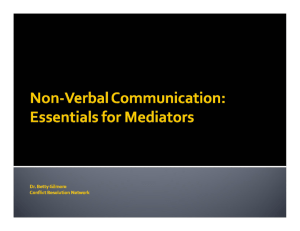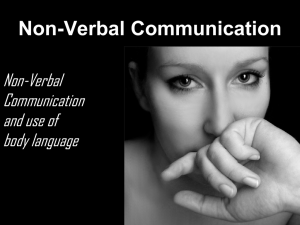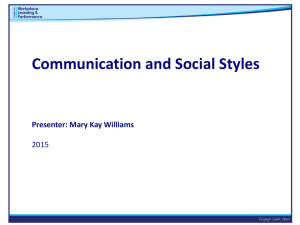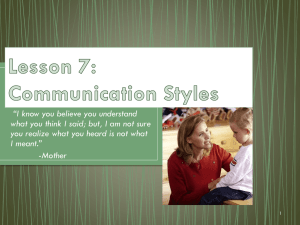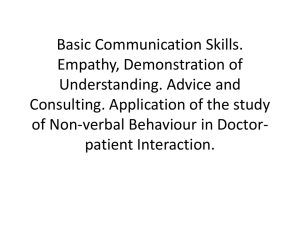Dimensions of Non-verbal Communication
advertisement
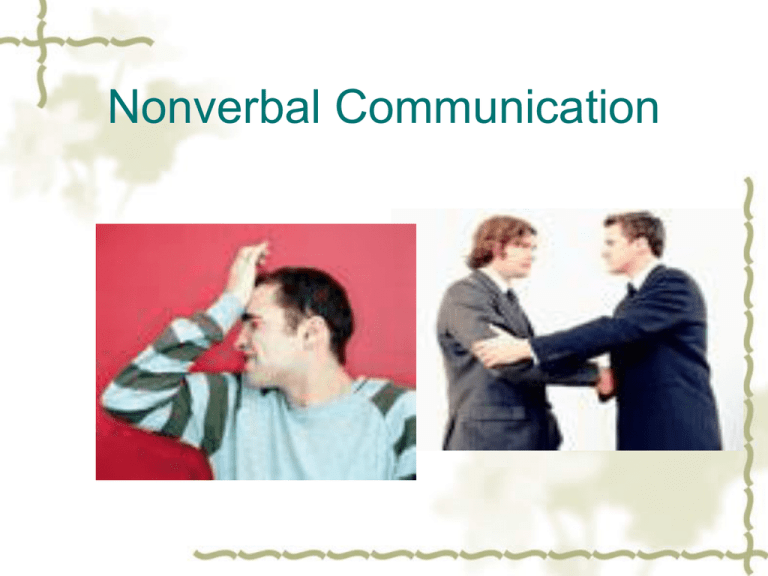
Nonverbal Communication Summary of Verbal Communication Language permits us to remember the past, deal with the present, and anticipate and plan for the future. Language serves as a guide to how a culture perceives reality. Each of us learns and uses language as we do because of our cultural background. Communication style varies from culture to culture, but one’s communicative style is adaptive and can be developed. Reviewing Verbal Communication To know another’s language and not his culture is a very good way to make a fluent fool of oneself. Ping-Pong and Bowling conversation styles High involvement conversation patterns and high considerateness patterns. High Involvement Styles HIS tends to: Talk more; Interrupt more; Expect to be interrupted Talk more loudly at times Talk more quickly Enjoy arguments E.g. Russian, Italian, Greek, Spanish, South American, Arab and African High Considerateness Styles HCS tend to Speak one at a time; Use polite listening sounds; Refrain from interrupting; Give plenty of positive and respectful responses E.g. Asian cultures: Chinese and Japanese Linear versus Circular = straight line discussion versus a more circular approach Direct versus Indirect = meaning conveyed by words versus through suggestion Detached versus Attached = objective presentation versus expressive style Intellectual Engagement versus Relational Engagement = Discussion is about the task versus discussion about the task and the person Concrete versus Abstract = example driven versus theory driven discussion Dimensions of Non-verbal Communication Major Topics: Introduction to the main dimensions Functions of non-verbal communication First impressions Observing non-verbal communication Visual introduction of gestures Non-verbal Communication: definition and importance Nonverbal communication involves all those nonverbal stimuli in a communication setting that are generated by both the source and his or her use of the environment and that have potential message value for the source or receiver. Non-verbal Communication: definition and importance It expresses meaning or feeling without words. It is the silent language of the culture. 93% of a message is transmitted by the speaker’s tone of voice and facial expressions. Only 7%of the person’s attitude is conveyed by words. Many, and sometimes most, of the critical meanings generated in human encounters are elicited by touch, glance, vocal nuances, gestures, or facial expression with or without the aid of words. From the moment of recognition until the moment of separation, people observe each other with all their senses, hearing pause and intonation, attending to dress and carriage, observing glance and facial tension, as well as noting word choice and syntax. We make important judgments and decisions concerning the internal states of others by their nonverbal behavior. Non-verbal communication is usually responsible for first impressions. Many of our non-verbal actions are not easily controlled consciously, so they are relatively free of distortions and deception. Functions of non-verbal communication 1. Supporting speech Repeating; Complementing; Substituting; Regulating; Contradicting 2. Conveying emotions The total feeling comes from 7% verbal, 38% vocal, 55% facial and body messages. 3. Creating positive feelings approach messages, availability messages, sensory stimulation, personal closeness and warmth Non-verbal vs. Verbal Communication To accent 加强 To complement 补充 To contradict 相反 To regulate 调节 To substitute for 替代 Types of Nonverbal Communication Voice (paralanguage 副言语) Body movements (kinesics 人体语) Space (proxemics 空间语) Touch (haptics 接触语) Time (chronemics 时间语) Other (chemical/ physical/ artifactual物 品的 codes, etc.) Paralanguage: How something is said Vocal characterizers: laughing, crying, yelling, moaning, belching, yawning, help reveal a person’s physical or emotional state Vocal qualifiers: volume, pitch, rate, tone, rhythm, resonance Vocal segregates: non-word fillers, e.g. hmmm,uh-huh, Paralanguage can assist us in drawing conclusions about the speaker’s emotional state, socioeconomic status, height, weight, age, intelligence, race, regional background, and educational level. Body Language (Kinesics) Facial expressions Smile may express pleasure, show affection, convey politeness, disguise true feelings, cover emotional pain or embarrassment. It is also a source of confusion: when and to whom to smile. Eye Contact and Gaze It serves to show intimacy, attention, and influence, and also to regulate interaction, define power and status relationships. Insufficient or excessive eye contact can create communication barriers. Never trust a person who doesn’t look you in the eyes. But in Asian countries, a person’s lack of eye contact toward an authority figure signifies respect and deference. Gestures Refer to the handouts E.g. the O.K. gesture; relax with feet up on the desk Touching (Haptics) Rules of touching: whom to touch and where they may be touched; shake hands, hug, be intimate with, touch the head, kiss Touching (haptics) Touching behavior reflects the culture’s attitudes and values. Cultures that believe in emotional restraint and rigid status distinction (German, English, Scandinavian, South-east Asian) do very little touching as compared with cultures that encourage outward signs of affection (Latin American, Middle eastern, Jewish, Greek, Eastern European). When greeting… Hold hands together in front of their chins in a prayerlike position and nod their heads. Middle Easterners, esp. Muslims Hug and kiss on the cheek for both the same and the opposite sexes. Friends will pat each other on the back Japanese People from France, Spain, Italy, Portugal and other Mediterranean (地中海) countries People from India, Sri Lanka, Thailand , and Bangladesh孟加拉 Men will embrace and kiss one another. Women may do the same. But the opposite sexes should avoid body contact. Bow to each other and keep hands slide down toward the knees or remain at the side Kiss on both cheeks. Most Latinos Proxemics Personal space and territory Conversational distance Reading Case 25 Chronemics The study of the meanings, usage and communication of time, time attitude, use of time frames, punctuality Monochronic and polychronic time One thing at a time, many things at once Reading Case 23 First Impressions See handouts ! Observing non-verbal communication What to watch for when you go abroad or are around foreigners? Use of space Eye contact and touching Gestures Questions to ask: How close did people stand or sit? How much touching? What kind of eye behavior? What gestures? How could you tell when a conversation was going to end? How can you determine the social relationship between people?

